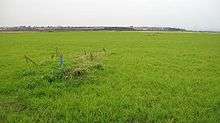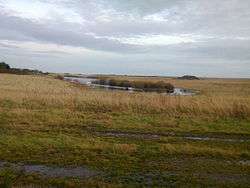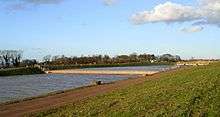Blindwells
Blindwells is a place in East Lothian, Scotland.

A former open-cast coal mine north of Tranent on the north-east side of the A1 just east of the Prestonpans/Tranent junction, adjacent to the estates of the Earl of Wemyss and March. As of plans in 2010 it is intended that the Blindwells settlement will consist of around 1,600 houses, and is part of East Lothian's planned 4,800 house total.[1] The settlement would include its own community centre, pre-school facility, primary and secondary schools and commercial aspects. Though the planned 1,600 houses implies a smaller development than the Scottish New Towns created in the sixties this could be expanded to accommodate another 2,500 to 3,000 houses in the future, for which a total of 130 hectares are earmarked.[2]

A series of man-made earth embankments were constructed for the purpose of settlement tests, to demonstrate that the site is stable enough for the purpose of building on.[3]
There has long been a pool on the northern part of the site and this has attracted some birds as it is currently one of the few standing open waters in East Lothian. Waterbirds regularly seen here include mute swan*, mallard*, common teal, wigeon, tufted duck, little grebe*, moorhen* and coot* (* confirmed breeding since 2008 [4]). Gadwall also bred in 2012 with two broods seen in 2014. Regular counts are undertaken for BTO Wetland Bird Survey (WeBS) monitoring.[5] Other characteristic birds of the site include grey partridge*, common kestrel, common buzzard, stock dove, skylark*, common grasshopper warbler, sedge warbler*, tree sparrow, reed bunting* and yellowhammer*, with altogether 29 species confirmed to breed in the period 2008-2013, with 17 "probable" breeders and a further 9 "possible" breeders (using BTO Atlas classifications [6]). Scarcer species recorded include little egret, northern shoveler, greater scaup, smew (drake plus 3 redheads, Feb 2012[7]), marsh harrier (occasional extended presence), common quail, wood sandpiper, spotted redshank, black-tailed godwit, short-eared owl and barn owl.
There is rich insect fauna too with nine species of dragonfly and damselfly having been recorded[8] including red-veined darter[9] and there is a colony of grayling and Narrow-bordered five-spot burnet moth, which is currently on the edge of its UK range in this part of Scotland (photo, right).[10]
Minewater Treatment Scheme


A reedbed treatment scheme for minewater, covering an area of 2.5ha, has been constructed to the east of the natural pond at Blindwells. It consists of a 30m long precast concrete cascade, 1.2m deep conditioning zone and 3 N° reed beds with associated inlet and outlet structures. The reed bed levels have been designed to give a gravity flow through the system and also a piped bypass system.[11] The photos here were taken in April 2009 when the reedbeds had only just begun to develop; by summer 2012 there was no sign of open water as dense vegetation was covering each of the pools. Reed harvest commenced spring 2015.[12]
See also
References
- ↑ http://www.eastlothian.gov.uk/info/207/planning-policies/302/development_frameworks/5
- ↑ http://www.edinburgharchitecture.co.uk/blindwells_tranent.htm
- ↑ http://www.scotsman.com/news/developers_use_man_made_hills_in_land_test_1_1193991
- ↑ http://www.the-soc.org.uk/se-atlas/
- ↑ http://www.bto.org/webs/
- ↑ http://www.bto.org/volunteer-surveys/birdatlas
- ↑ http://www.birdinglothian.co.uk/#/2012-highlights/4572603415
- ↑ http://wildlifeinformation.co.uk/recording_events_blindwells_20090829.php
- ↑ http://www.wildlifeinformation.co.uk/archive_news.php
- ↑ http://ukmoths.org.uk/show.php?bf=171&map=true
- ↑ http://coal.decc.gov.uk/en/coal/cms/environment/schemes/blindwells/blindwells.aspx
- ↑ http://sedgewarbler.blogspot.co.uk/2015/04/blindwells.html
Coordinates: 55°57′25″N 2°56′10″W / 55.957°N 2.936°W